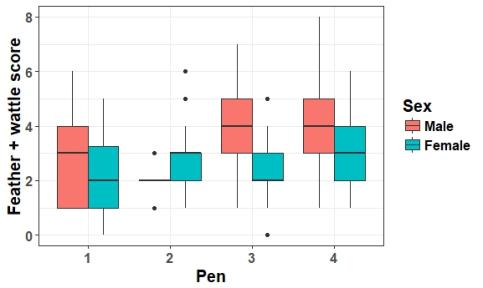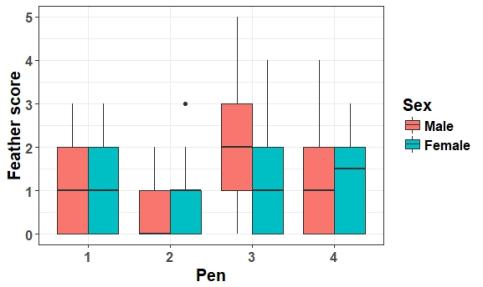Feather condition
Total feather condition

Assessment of body condition at the end of experimentation showed that there was a significant difference in combined feather, comb and wattle scores different pens. A post-hoc Dunn-test showed that hatchery pens had significantly higher feather damage than control pens (p<0.05). The results were not significant when comparing pens from the same treatment group (p>0.1).When comparing the total feather damage between pens for just males the difference was also significant. A post-hoc Dunn-test was also conducted on the male data, with significant or tendency towards differences between pens containing chickens from different treatment groups (p<0.1). There were no significant differences between pens of the same treatment groups (p>0.1). There were no significant differences between pens when comparing just females (p>0.1). When comparing sexes within treatment groups hatchery males had significantly higher feather condition scores than hatchery females (p<0.05), however, there was no significant difference between control male and females (p>0.1).
Feather condition

When analysing the feather scores separately, hatchery pens also had significantly higher feather damage than control pens (p<0.05). A post-hoc Dunn-test showed significant differences between pen 2 and 3, and pen 2 and 4 (p<0.05). A tendency was found between pen 1 and 3 (p<0.1). There was no significant differences between; pen 1 and 2, pen 1 and 4, and pen 3 and 4 (p>0.1). Hatchery males also had significantly higher feather damage than control males (p<0.05). Analysis of pen differences found a significant difference between pen 2 and 3 (p<0.05), and tendencies were found between pen 1 and 3, and pen 2 and 4 (p<0.1). There were no significant differences between the other pens (p>0.1). There were also no significant difference when comparing females of different treatment groups, control males and females, and hatchery males and females (p>0.1).
Comb and wattle condition

Comb and wattle scores were also analysed separately. Hatchery chickens showed significantly higher comb and wattle damage than control chickens (p<0.05). After a post hoc analysis of pen differences a significant interaction was found between pen 1 and 4 (p<0.05), and a tendency was found between pen 2 and 4 (p<0.1). There were no other significant interactions between pen (p>0.1). Hatchery males also had significantly higher feather damage than control males and a significant interaction was found between pen 1 and 4, and pen 2 and 4 (p<0.5). There were no other significant interactions when comparing males of different pens (p>0.1). There was also a tendency towards hatchery females having higher comb and wattle damage than control females (p<0.1), however upon further analysis there were no significant interactions between pens (p>0.1). When comparing sexes within treatment groups it was found that hatchery males had significantly higher comb and wattle damage than hatchery females (p<0.05), however, there was no significant differences when comparing control males and females (p>0.1).
Responsible for this page:
Director of undergraduate studies Biology
Last updated:
05/27/18
